The World’s Largest Cave – Hang Son Doong Cave in Vietnam
Hang Sơn Đoòng also known as Sơn Đoòng cave is a solutional cave in Phong Nha-Kẻ Bàng National Park, Bố Trạch District, Quảng Bình Province, Vietnam. As of 2009 it has the largest known cave passage cross-section in the world, and is located near the Laos–Vietnam border. Inside is a large, fast-flowing subterranean river. It was formed in Carboniferous/Permian limestone.
The World’s Largest Cave
Hang Sơn Đoòng also known as Sơn Đoòng cave is a solutional cave in Phong Nha-Kẻ Bàng National Park, Bố Trạch District, Quảng Bình Province, Vietnam. As of 2009 it has the largest known cave passage cross-section in the world, and is located near the Laos–Vietnam border. Inside is a large, fast-flowing subterranean river. It was formed in Carboniferous/Permian limestone.
Discovery
Hang Sơn Đoòng was found by a local man named Hồ Khanh in 1991. The whistling sound of wind and roar of a rushing stream in the cave heard through the entrance as well as the steep descent prevented the local people from entering the cave. Only in 2009 did the cave become internationally known after a group of scientists from the British Cave Research Association, conducted a survey in Phong Nha-Kẻ Bàng from 10 to 14 April 2009. Their progress was stopped by a large, 60-metre (200 ft) high calcite wall, which was named the Great Wall of Vietnam. It was traversed in 2010 when the group reached the end of the cave passage.
Description
According to the Limberts, the main Sơn Đoòng cave passage is the largest known cave passage in the world by volume – 38.4×106 cubic metres (1.36×109 cu ft). It is more than 5 kilometres (3.1 mi) long, 200 metres (660 ft) high and 150 metres (490 ft) wide. Its cross-section is believed to be twice that of the next largest passage, in Deer Cave, Malayasia. The cave runs for approximately 9 kilometres (5.6 mi) and is punctuated by 2 large dolines, which are areas where the ceiling of the cave has collapsed. The dolines allow sunlight to enter sections of the cave and has resulted in the growth of trees as well as other vegetation.
Son Doong is considered to be the largest cave in the world, based on volume and also the biggest cave in Vietnam, found by Ho Khanh – a Phong Nha jungle man in 1990. In 2009, Hang Son Doong was officially surveyed and measured by the The British -Vietnam Cave Expedition Team led by Howard Limbert. The Expedition team then announced it as the world’s largest natural cave with a volume of 38.5 million m3. The measurements were then accepted by a number of world’s senior karst geologists including Dr. Tony Waltham. This team along with National Geographic magazine had announced Son Doong Cave as the largest natural limestone cave on the planet in the same year. In 2013, the Guinness World Records Organisation recorded it as the world’s largest natural cave.
Many people mistook Son Doong Cave – the largest cave in the world with Mammoth Cave – the world’s longest-known cave system, located in Mammoth Cave National Park ( an American national park in west-central Kentucky) and that Son Doong is the largest cave passage. However, this article will clarify the misunderstanding as well as give you a better acknowledgement of Son Doong Cave and its exploration. The cave contains some of the tallest known stalagmites in the world, which are up to 70 m tall. Behind the Great Wall of Vietnam were found cave pearls the size of baseballs, an abnormally large size. source
Origin of the name Son Doong
Traditionally, those who found the cave will name it. Therefore, Ho Khanh and the expert team discussed and decided to call the cave Son Doong (a combination of 2 words: Son means mountain, Doong is the name of the valley where the ethnic minority Bru Van Kieu lives, and the Thuong river coming from, or also means the cave in the limestone mountain with an underground river flowing through).
Unique features of Son Doong Cave
The Son Doong Cave has a total length of nearly 9 km long and the volume is up to 38.5 million cubic metres, which makes this cave the largest natural cave on the planet. With this volume, Hang Son Doong is 5 times larger than Deer cave in Malaysia, which was said to be the largest natural cave ( before Hang Son Doong was discovered) with 9.5 million cubic metres of volume. However, what makes Son Doong special, recognized and well-known by the world is the unique hidden underground world inside the cave itself. It has many complex and giant stalactites (over 80m high), primaeval rain forests growing inside the cave, its own ecosystem, weather or a mysterious underground river that no explorer has yet discovered to the end of it. Many visitors admitted that the Hang Son Doong Cave is like another world, Ginger Zee from ABC News’s – Good Morning America exclaimed that the sceneries in Son Doong were like those in the Avatar movie.
This amazing cave also houses an impressive ecosystem, inside the largest cave passage in the world. This huge and intricate cave system was created by the underground river, and filled with formations from the water that percolated down from a rainforest above. More of the highlights only found in this cave are:
There is one of the largest sections of Son Doong; from the beginning of this passage, you can see the light from Doline 1, 1.5km away. Estimated by cave experts that a 40-storey skyscraper can easily fit in this passage and it is large enough for a Boeing 747 to fly through. Moreover, the world’s tallest stalagmite, about 80m tall, is also located in this passage.
Underground river
Doline 1 – Watch out for Dinosaurs
Doline 2 – Garden of Edam
Cave pearls
Passchendaele Passage
The Great Wall of Vietnam
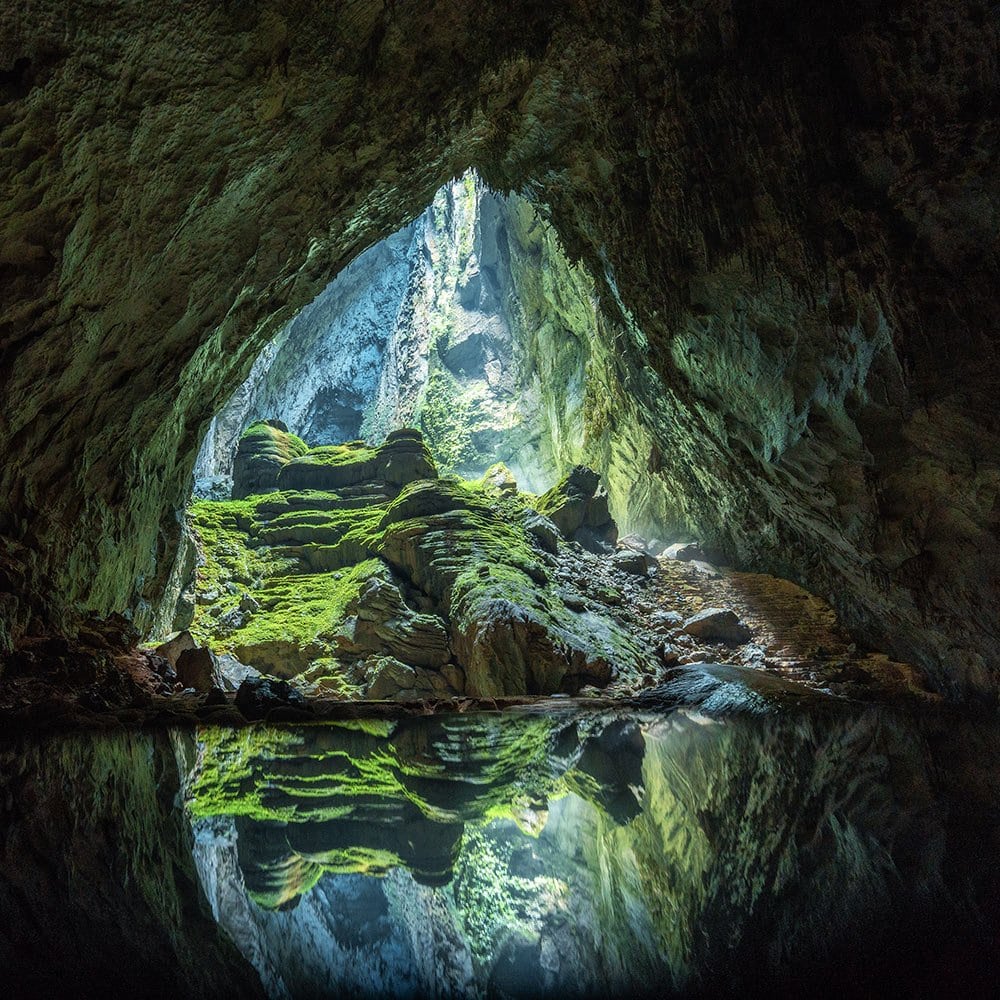
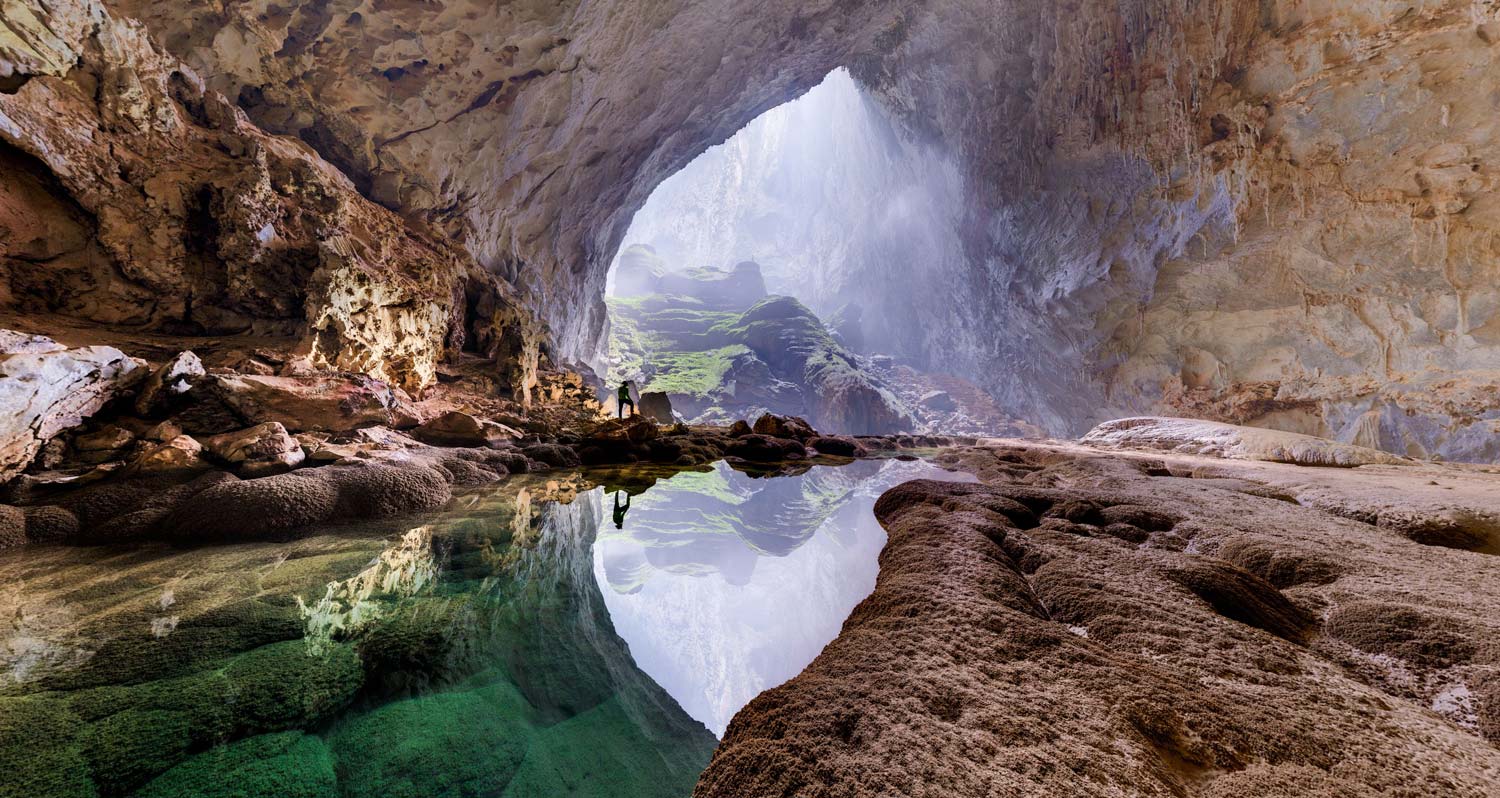
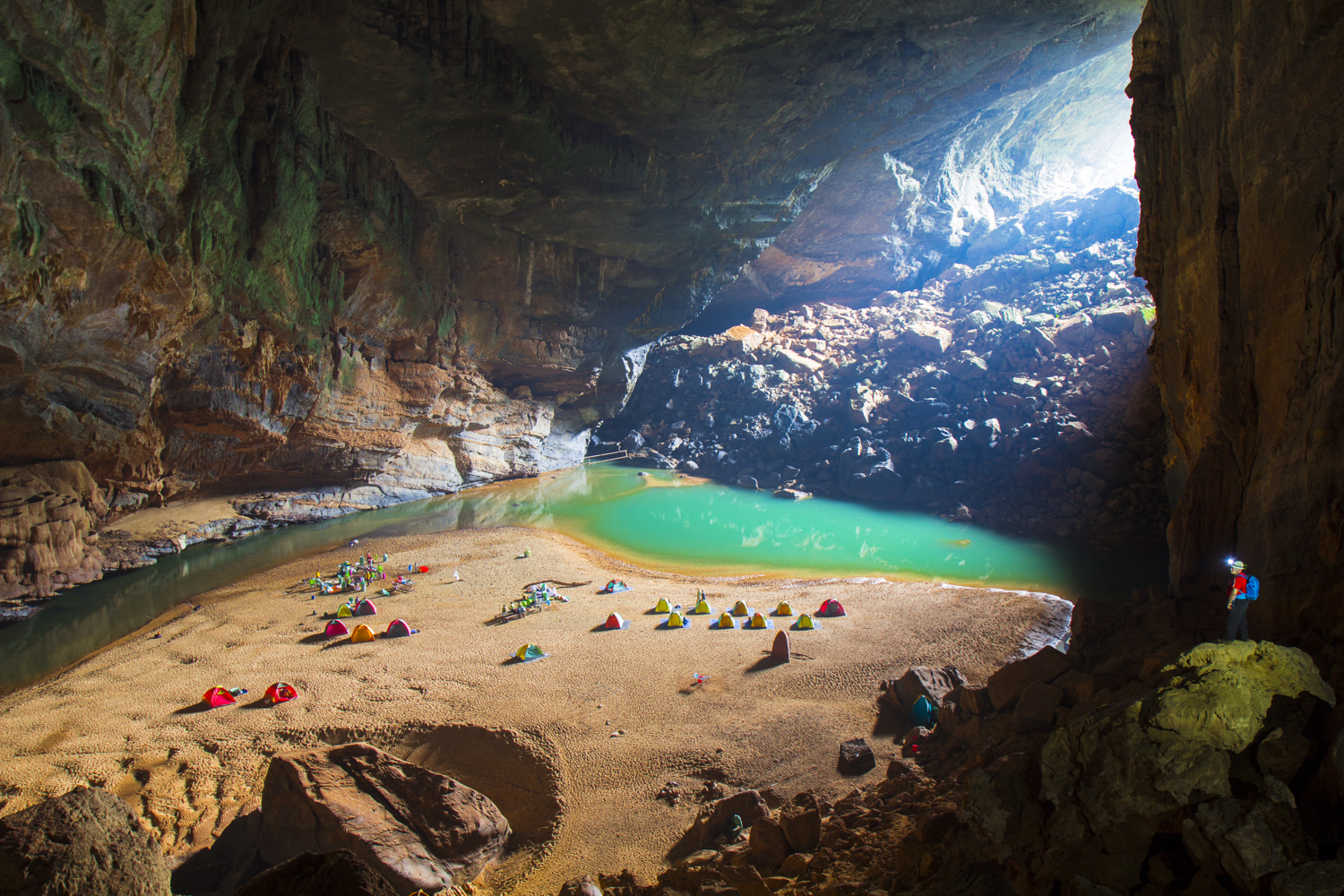
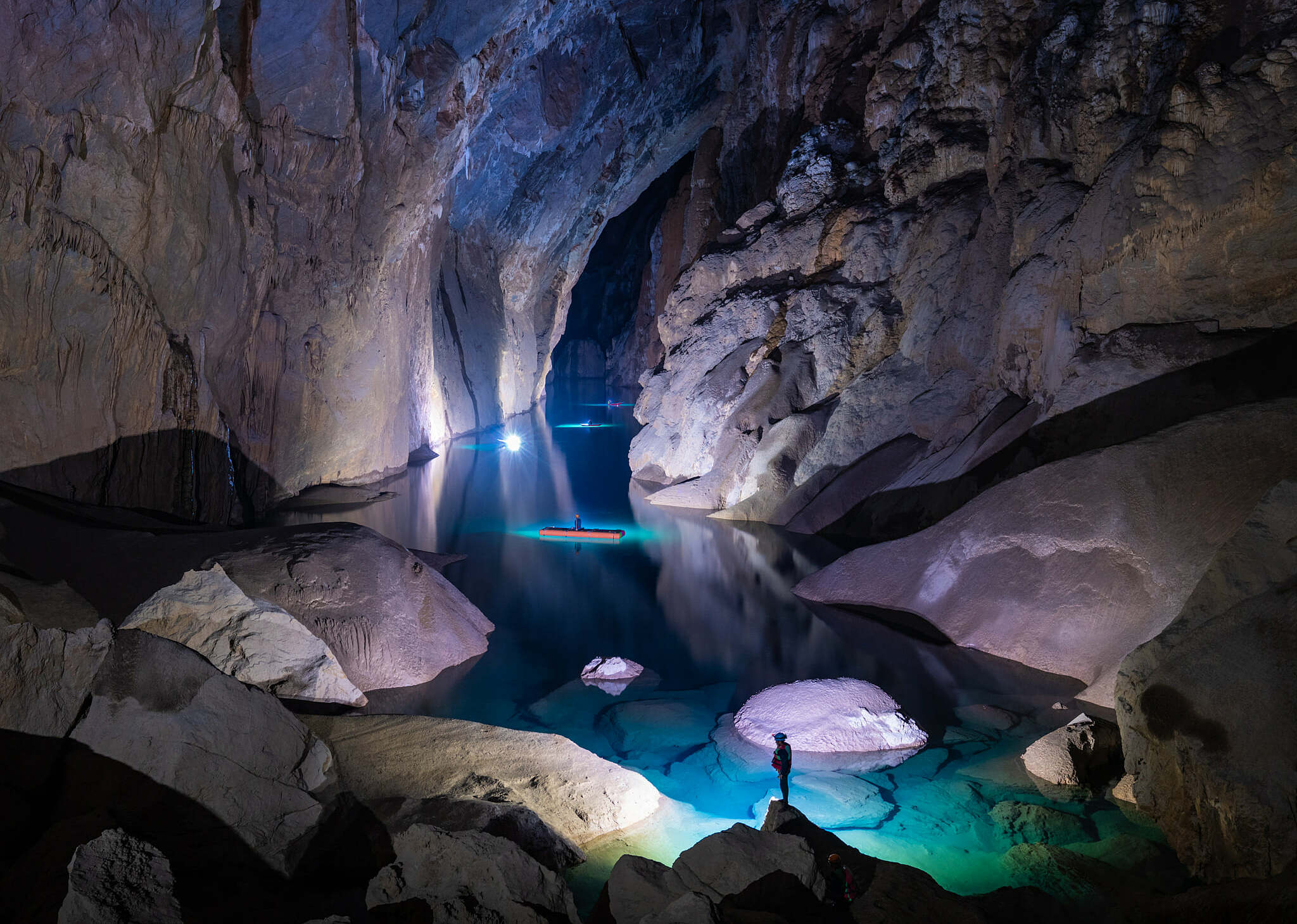
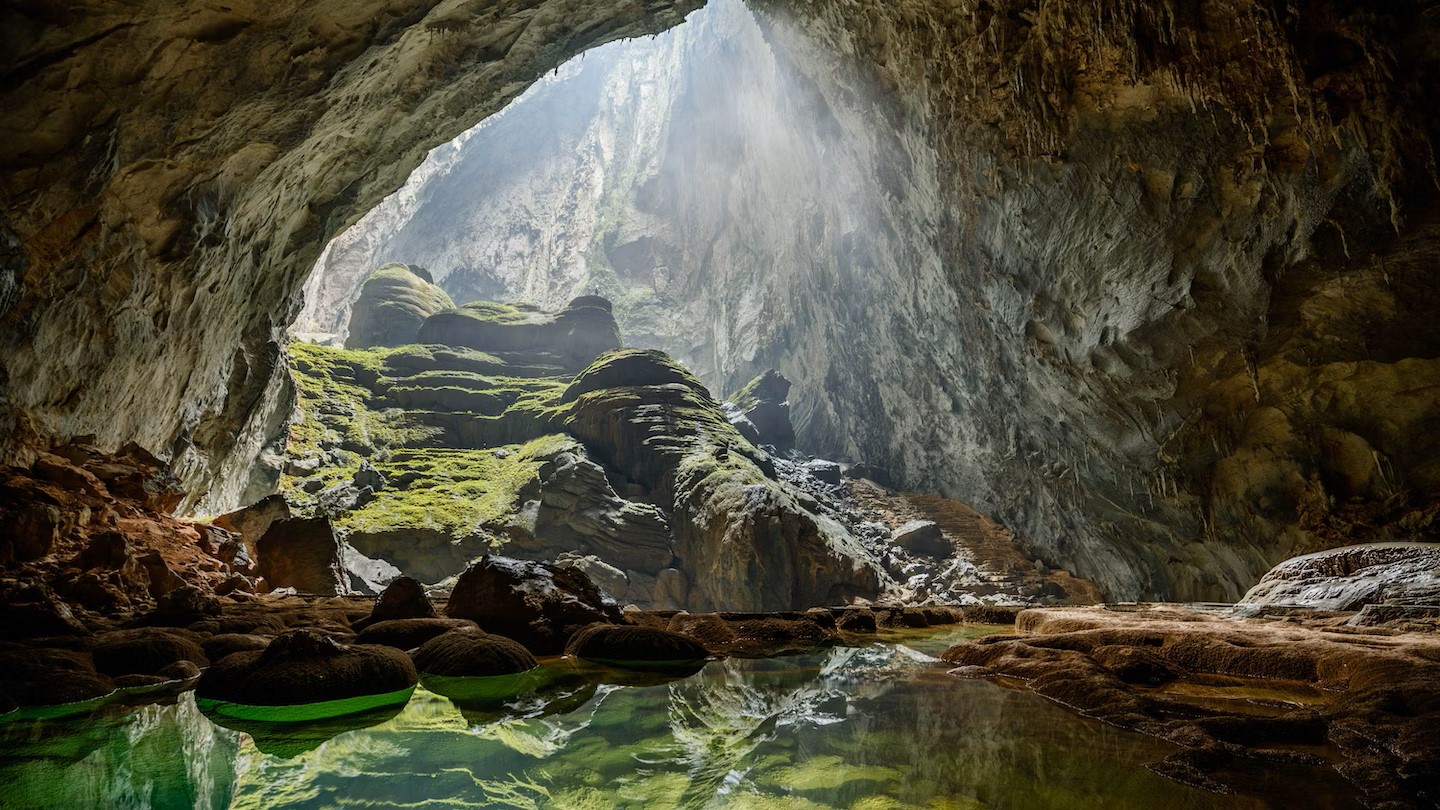
Hope and Vision Passage inside Son Doong Cave
Hope and Vision is a large passage about 1.5km from the second river crossing session to Doline 1 in Son Doong Cave. With a giant cave dome, the cave explorers have described that this passage is big enough so that a Boeing 747 could easily fly through. 1.5km away from the beginning of the passage, visitors can see the dim light coming into the cave from the first Doline.
In the Hope and Vision passage, 40m below the path of the explorers, there is an underground river flowing and there is an iconic stalagmite called “Hand of Dog” and a huge cave formation considered as the tallest stalagmite by the cave.
The world’s tallest stalagmite in Hope and Vision
Hope and Vision Stalagmite located at the gateway of the passage, right after the underground river crossing inside Son Doong Cave. In 2009, British – Vietnamese Cave Expedition Team had measured and confirmed this stalagmite is 80m high. Additionally, directly on this stalagmite Ginger Zee, a famous host ABC News, sent a good morning to America on the Good Morning America show in May 2015.
This stalagmite could be the tallest stalagmite in the world with a height of 80m. That is lot taller than the stalagmite listed by the Guinness as the world’s tallest stalagmite in Zhi Jin Cave of China with 70m high.
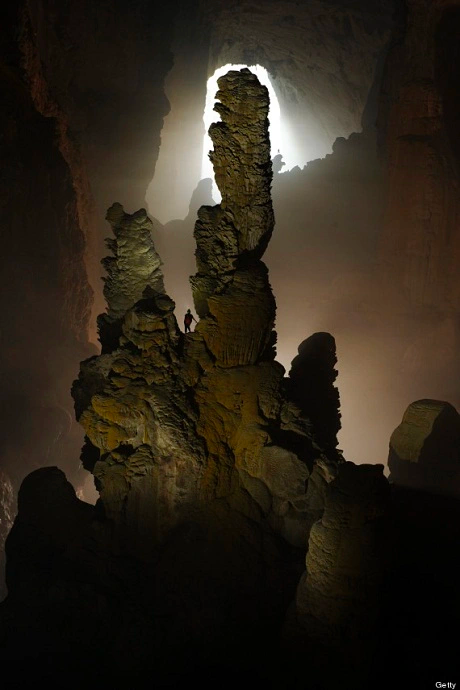
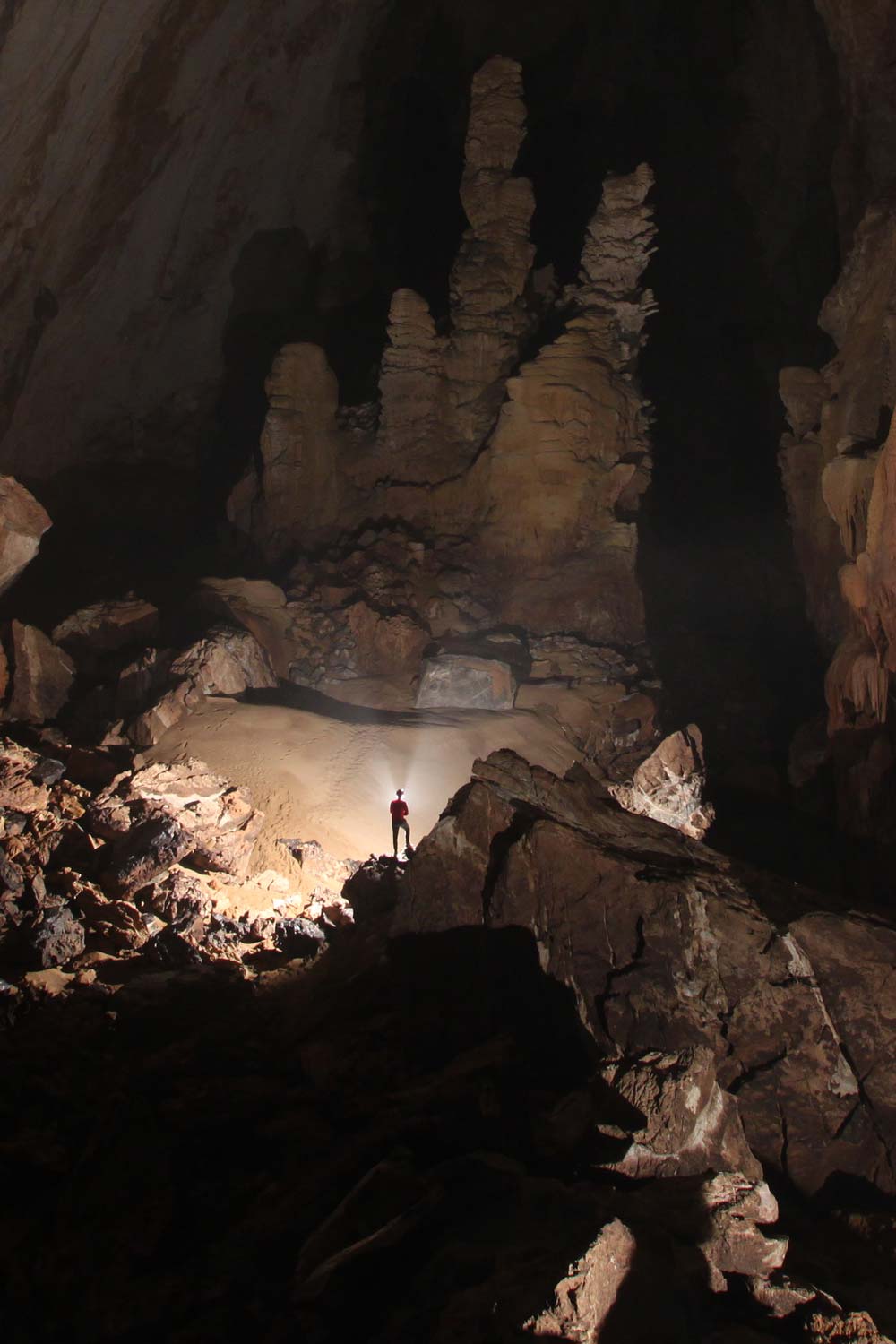
Stalagmite formation named Hope and Vision has a height of 80m. Measured by the British-Vietnamese caving team using laser equipment in 2009. This stalagmite is currently the tallest stalagmite in the world.
The Hand Of Dog
The Hand of Dog is a giant stalagmite structure (the mushroom-like stalagmite) located between the areas that are known as Hope and Vision and Doline 1, about 2km from the entrance of Son Doong Cave and about 1 km from Doline 1 in Son Doong Cave. The reason for its incredible size – about 60m high – is because it was formed in an area of the cave where the roof is nearly 100m high and water droplets carrying calcium mineral (calcium carbonate) have flowed down at this point for hundreds of thousands of years. At a special viewpoint it is possible to see both huge stalagmites and take wonderful pictures.
The origin of Hand Of Dog
In the exploration to Son Doong Cave in 2009, members of the expedition were divided into groups of 2 people to conduct survey and measurement with laser light. Two experts Helen Brooke and Trevor Wailes were assigned to analyse the expansion of the cave and draw a map of this area. Because the cave passage was too large, experts had to segment and name each corridor for easy identification.
While Helen Brooke with laser equipment was responsible for going ahead and measuring the parameters of the cave, Trevor Wailes recorded measurements and described surrounding areas to draw a map.
As she approached the area, Helen saw a rock jutting out like a child’s hand, as in a television series she had just seen when she was a child. The shadow of the stone got clearer from the beams of light from the Sinkhole 1 that was more than 1km away. Helen decided to name this stalagmite the Hand of God. However, the distance between the 2 experts was quite far. Trevor misheard what Helen said, so he wrote Hand of Dog into the map instead. After the name Hand of Dog in Son Doong was recorded on the map, no one can change that name anymore.
This is an iconic stalagmite (not Hand of Dog stalactite) of Son Doong cave. Before approaching Hope and Vision, when looking towards Doline 1, visitors can see the silhouette of this iconic stalagmite looming up, with the light from the Doline behind, and the mist creating a majestic viewpoint in the largest cave in the world.
Camping in the clouds
The Hope and Vision passage in Son Doong Cave leads to the first campsite inside Son Doong. As you approach the base of the Hand of Dog stalagmite in Hang Son Doong Cave, you will see the first campsite, also known as ‘The Level Playing Fields’ nestled below the giant cave wall. From the campsite, we can see Doline 1, often hidden behind a layer of mist. The sound of the underground river can be heard but not seen from the campsite.
From the top of the chamber right next to the Hand of Dog you may see a layer of mist lying just below the campsite. Along with the sunlight coming in from outside the Doline, it makes people feel like the camp is on cloud nine.
This is a campsite that can pique your interest, from the steamy air, the sound of rushing water in the distance to the cooling temperature and a mystery layer of mist that comes and goes without any warning. You can feel the full spectrum of 4 seasons in just one night.
- Do stalagmites stop growing if you touch them?
- What’s the difference between a stalagmite and a stalactite?

